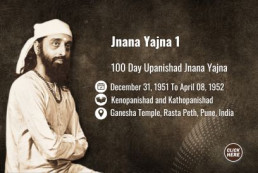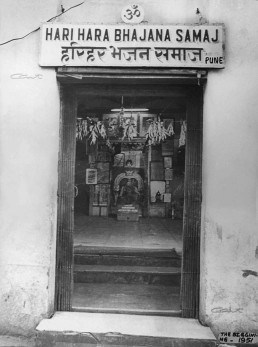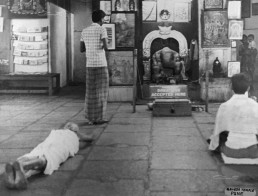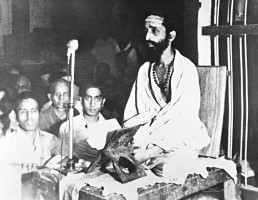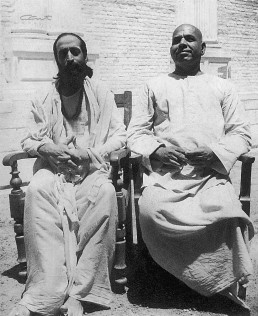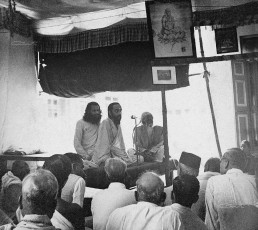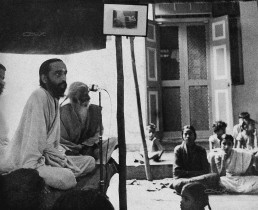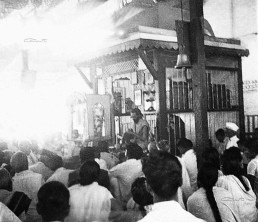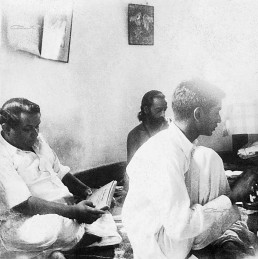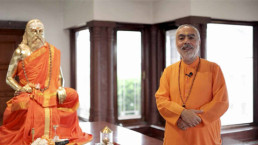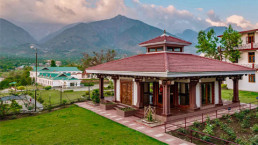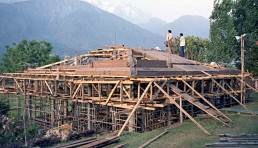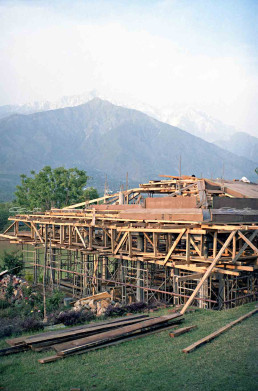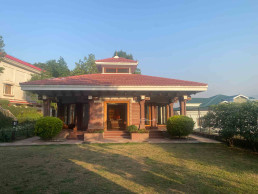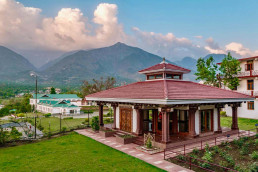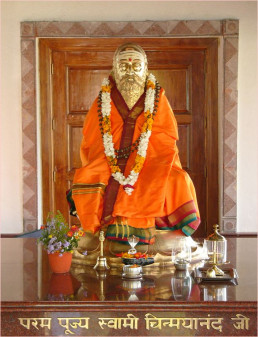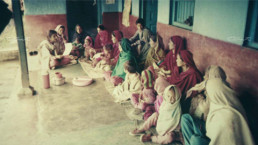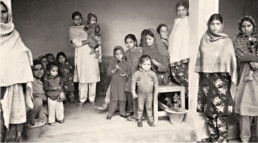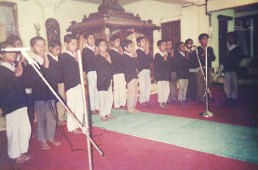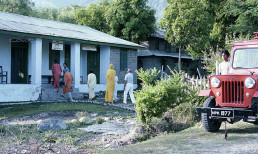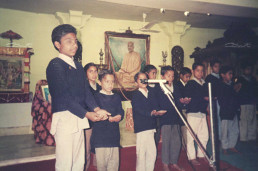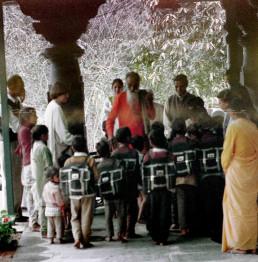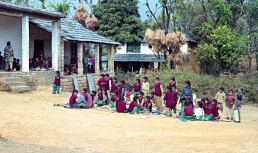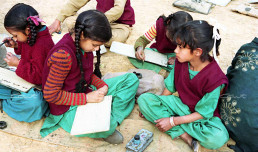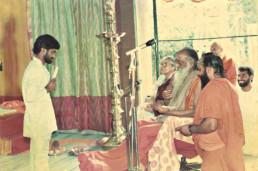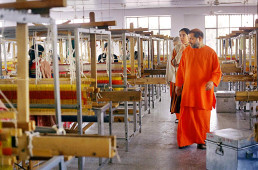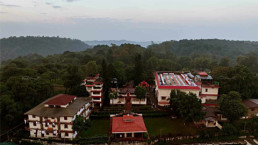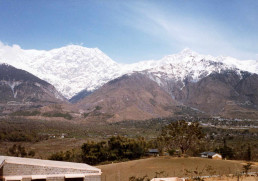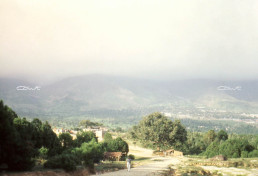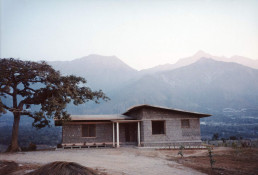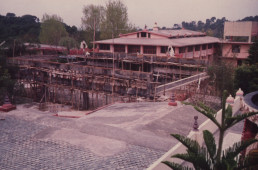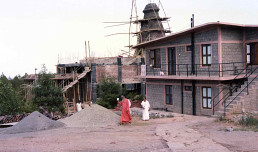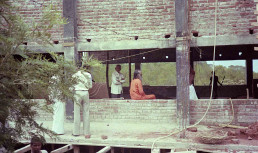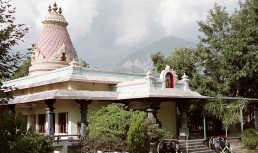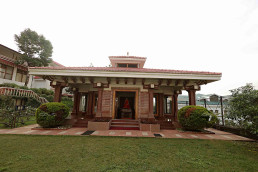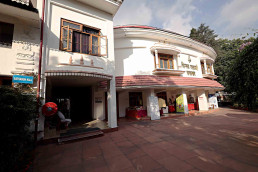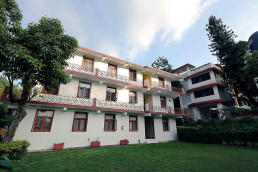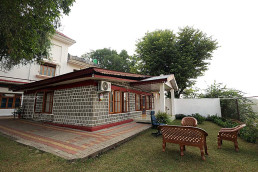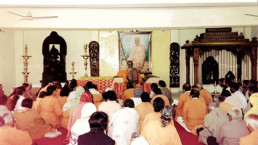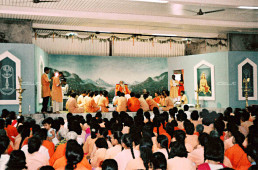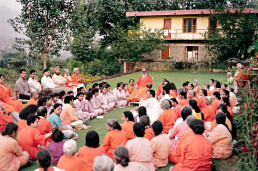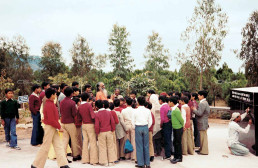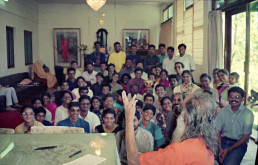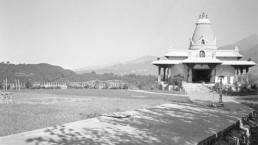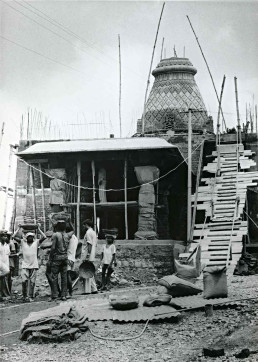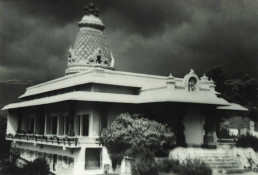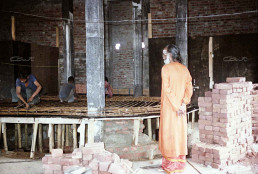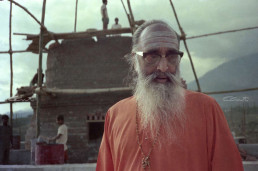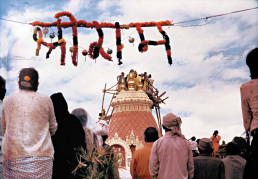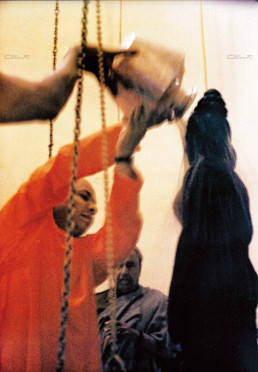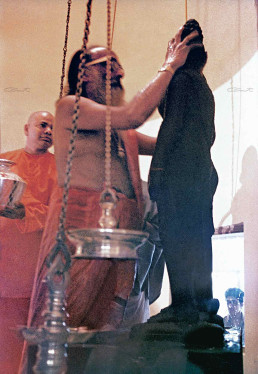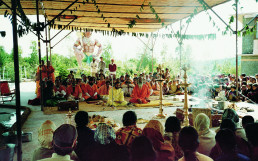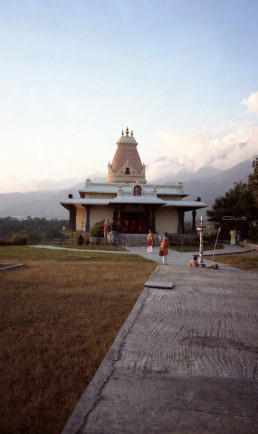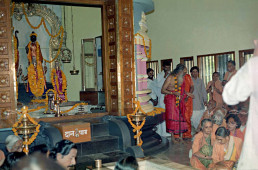Jnana Yajna 1
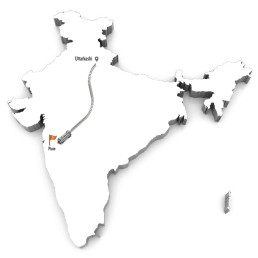
Jnana Yajna 1

Year & Dates:
December 31, 1951 to April 08, 1952

Yajna Topics:
Kenopanishad and Kathopanishad

Place:
Ganesha Temple, Rasta Peth, Pune, India.
True to His deep conviction that “Hinduism in its whole vigour and power is in the Upanishads,” Pujya Gurudev Swami Chinmayananda’s first Jnana Yajna was an extraordinary offering of Knowledge in its most strong, sublime form. His plan was bold – a 100-day Yajna where the Swami would expound on the exalted Truth declared in Kenopanishad and Kathopanishad. In spite of hesitation, lack of support, and even opposition from varied quarters, His painstaking, selfless efforts to give the Highest were like opening the floodgates of an ocean of Knowledge.
Vedantic Renaissance Begins
From an audience of only 18 on the first day of His Jnana Yajna on Dec.31, 1951, at the small Ganesha Temple in Rasta Peth, Pune, the crowds swelled to over a thousand to hear the glory of Hindu Scriptures explained in English and experience the power of Vedanta Shravanam. For a hundred days, the Yajna evoked the Highest; the unique format of the Jnana Yajna with daily Upanishadic discourses, Akanda Kirtan, bhajans, and clearly-explained homas conducted by priests uplifted an audience that had been motivated to also practice brahmacharya to absorb the essence of the Supreme Knowledge.
A tireless, fearless Sage had taken up the divine sankalpa of a Vedantic Renaissance.
There was no turning back – the Goal was glorious, and the Way was lit with Grace and great blessings of Mother Shruti and His Gurus.
In Admiration
Shri Madhukar Veeraswami Naidu of Chinchwad, Pune recalls how he was compelled to attend the discourses of the first Jnana Yajna. He had been a regular visitor to the Ganesha temple, solely interested in taking the prasad, which was distributed in the evening. He was much drawn towards this young swami there holding forth so eloquently on the scriptures. “My mission is to convert Hindus to Hinduism,” said Gurudev. These words still ring in Naidu’s ears. Here was a swami, a stranger to Pune, lived in Madras Dharamshala, dyeing ochre the cloth given to him by some devotees, speaking impeccable English, wearing a unique head-dress, and working with missionary zeal. All these traits appealed to the residents of Poona at that time.
Pujya Gurudev thus sounded the auspicious conch of the Chinmaya Movement on 31 December 1951 at Pune. A saffron flag with the mystic syllable ॐ inscribed on it was first hoisted there.
For the complete story of the first Jnana Yajna: Story Behind First Jnana Yajna; Jnana Yajna Part 1; Jnana Yajna Part 2
Photo Gallery
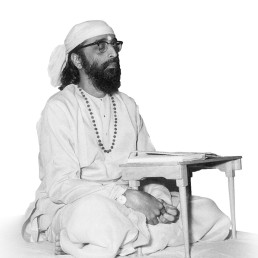
“Think,” Says Pujya Gurudev
“Though the Guru indicates to the burning aspirant that Truth is “that Life Centre which manifests as the power of sight in the eye, the power of hearing in the ear, the power of speech in the tongue etc.,” he is equally anxious to warn the disciple; “ the Absolute Truth is that power which is in no way associated with any of its seeming conditionings such as the ear, eye, mind, etc.”
From Kenopanishad Yajna Prasad Vol.4, p.130
Wonderful is he who comprehends: – What a rare percentage of the whole can in each generation come to live the voiceless joy of their life’s fulfillment. The chance to hear is rare; even when heard to digest and understand those subtle ideas is rarer; a Master, who is efficient enough to initiate a student into the Absolute and satisfying all his doubts, guide him into the Realms Beyond is rarer and, even when an individual comes to be lucky to enjoy the blessings of all the above three, Lord Death says, only the luckiest one comes to experience Godhood in this very birth while listening to the teacher discoursing upon the Sruti texts.
From Kathopanishad Yajna Prasad, Vol.1, Part 3 p.107
Chariot of Wisdom
Transport yourself back to the enchanting era of 1951-52 and experience the profound first yajna. Fast forward to 1982, where a later yajna on Kathopanishad unfolds, offering a chance to relive the wisdom and insights.
Explore the profound metaphor of the chariot in this excerpt from a Kathopanishad discourse by Swami Chinmayananda in Toronto, Canada in 1982. Delve into the relationship between the Lower and Higher Self, understanding the mind as the steering wheel controlled by intellect. Discover how sense organs serve as trotting horses, dragging the body through the muddy roads of sensuality. Unravel the analogy of Arjuna as the individual in the body, with Krishna as the pure intelligence guiding the chariot. Join the insightful journey of self-contemplation and learn to navigate the roads of life with a pure intellect.
Kaushalya's Leadership
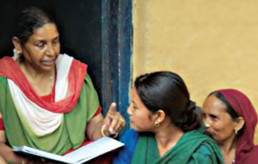
From Troubled Life to Role-Model
Kaushalya’s story is similar to Urmila’s but with a difference; her husband did not beat her. She had the support of a wonderful mother-in-law. However, her husband was drunk most of the time and did nothing to earn a living and support the big family. Kaushalya and her daughters worked as laborers in the agricultural fields of others and in their own little land and eked out a living to somehow have two meals a day.
Her eldest daughter, who is now married and well settled, recalls with tears in her eyes how, when she was sixteen years old, she wanted to go to school to study, but she had nothing suitable to wear. Her kameez (a long shirt that is worn over loose pants, the salwar) was torn, and she had already mended it several times. The kameez had ultimately torn beyond repair. She, however, had a woolen sweater which was fine. So she hid the torn part of the kameez uniform with the sweater and went to school all summer wearing the sweater! If anyone asked her whether she did not feel hot with the woolen sweater on, she would simply reply that she had a fever and felt cold! Thus, Kaushalya and her family lived in dire poverty when she joined CORD as a village health guide. Soon, like Urmila, she grew to be a team leader in the organization and a micro-entrepreneur at home. In 2000, she was elected as a member of the Zillah Parishad (District Council), which presided over the local self-governance of eleven Panchayats. She had hardly campaigned; however, she won the election by word of mouth of the villagers, who appreciated her sincere work.
While representing them at the district level, she successfully demanded response from local government to meet the needs of her constituency. Without hesitation, she trained many others, especially women, to become effective representatives of the people. For her comprehensive work on various issues, she too has been interviewed by news media several times, including the government’s All India Radio. In 2013, to CORD’s pride, Pujya Guruji Swami Tejomayananda felicitated Kaushalya as a ‘Karma Yogi’ in his inaugural address on ‘Karma Yog’ in New Delhi.
The essential advice that Kaushalya gives to new workers joining CORD is: “The key to work at the grassroots level is to build a lasting relationship with the villagers. Be a real friend in need who keeps his or her promises and delivers services on time.” Today, she helps CORD monitor, support, and build the Odisha and Punjab (Sidhbari satellite site) program, besides her many other responsibilities at Sidhbari. She was one of the main trainers who lived in Odisha for a few months to build and train the team of grassroots workers when CORD initiated the Program in Odisha.
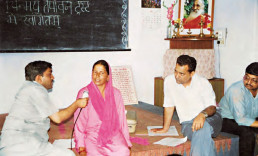
With the Guru’s Blessings
If Urmila Devi treasures the letter that she received from Gurudev and her photograph with him, Kaushalya Devi recalls how he appeared in her dream one night when she was emotionally down, and how the problem just evaporated the next morning! In February 1992, when Gurudev was recuperating from his illness at the Sidhbari ashram, Kaushalya stood in front of him with folded hands, inviting him to her eldest daughter’s wedding in Sidhbari. Gurudev looked at her kindly and said to her that he would not be able to come. He said, “I cannot sit down with you all nor can I eat oily food as my heart condition does not allow it.” He then inquired with care if she needed money for the wedding. Kaushalya at once said: “No, Gurudev, I only want your blessings.” To this, Gurudev replied: “Shaadi ki chinta mat karo, sab thik ho jayega” (Do not worry about the wedding; all will be well).
Kaushalya remembers this with gratefulness when she recalls how everything at the wedding went smoothly. Her husband and his alcoholic friends, whom she had expected to create noise and confusion, behaved well during the wedding; the limited food supply, which she thought would run out and embarrass her, was not only enough for all those who poured into her house from afternoon until night, but was enough left over for the family to consume the next morning! “The people still praise the tasty food that was served!” says Kaushalya with devotion and gratitude.
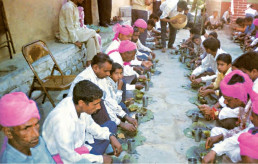
Urmila's Transformation

From Troubled Life to Role-Model
Urmila started as a clinic attendant in one of CORD’s subcenters. She was referred by the villagers because of her husband, who would beat her every day after a bout of drinking. He was a poor village carpenter with meager earnings that he splurged entirely on alcohol and other addictive habits. He was also a minor village bootlegger, a gambler, and a womanizer. One night, he even tried to sell Urmila to his drinking mates. That was when she ran away in the middle of the night with her four little children to her inlaws’ home, about five miles away, where she began to stay in a very small room given to her by her in-laws.
She had no money to feed the children. She would earn a little on some days by doing odd jobs in certain homes in the village. Her husband did not leave her alone. He would visit her from time to time. On some days, her husband came home drunk and kicked the food she and her children were about to eat after having been hungry all day and, as usual, beat them all for no reason. Expected to be the traditional bread winner of the family, he did not like the fact that she was the one who was earning some money and feeding the family. In fact, her condition was so desperate that the villagers advised her to live with some other man. Urmila did not want to get into any such type of relationship. Nevertheless, the villagers constantly kept pestering her to enter into such a relationship.
At that juncture, when CORD first met her, she was hiding her face behind her veil, emaciated, unable to utter a word except for an occasional nod. Then, Urmila started working as a clinic attendant on a wage of Rs. 50 per month! She was soon promoted because of her diligence. She was trained as a Village Health Guide by CORD. Her readiness to learn and transfer her health-related knowledge, and her ability to help implement the program with efficiency, enabled her to rapidly grow from a part-time worker (working twice a week for a few hours only) to a fulltime worker. CORD devoted much effort to build her knowledge and skills. Before long, she emerged as an excellent community-development worker and a team leader.
During her work with CORD, Urmila started learning, practicing, and transferring the skills and knowledge to change her own as well as other people’s lives in the community. In her free time, she worked with her growing children to earn extra income from her own microenterprise. She grew mushrooms at home and sold them to make a reasonable profit. Through CORD’s facilitation, she formed, nurtured, and strengthened CBOs of women called Mahila Mandal — Self-Help Groups for Microfinance Access; Adolescent Girls’ Groups; Farmers and Youth Groups; and Children’s Groups.
Urmila then started leading a team of women group facilitators at CORD as a supervisor and later as Chief Community Development Worker. Besides having that role, she herself won people’s confidence in her village through her consistent and persistent selfless work. She won the election and became the ward representative in her Gram Panchayat. She soon began to train others on how to function resourcefully in the Panchayati Raj Institution and promote local self-governance.

With the Guru’s Blessings
Both Urmila’s and Kaushalya’s (see next topic about Kaushalya) children are well settled today, and both of these women have managed to build their small comfortable homes. What they treasure most is their special moments with Gurudev, who gave them love and encouragement, which Guruji now continues to give. Urmila Devi recalls the time when, during a workshop on environment at Solan, Himachal Pradesh, she and her friend Vidya Devi won a cash prize of Rs. 500 in a speech competition about the ‘Environment.’ They were very excited and decided to offer this prize money at the feet of Gurudev. When they were trying with difficulty to reach Gurudev through the crowd of devotees around him, Gurudev noticed them and said loudly to the devotees, “Please give some space so that my people can come to me.” He then introduced them to the crowd, said that they were doing very good work, and blessed them. Later, Gurudev wrote to Urmila a letter which she still treasures today and says, “This is a letter to me from God.” (See the original letter and the typed version below)


Binta Devi's Story

From an Abused Widow to Active Entrepreneur
The following anecdote illustrates, through an individual beneficiary’s story, how the CBOs and the four strategic principles enable CORD to transform the lives of the poor people, who then mutually help each another. Moreover, the story depicts how CORD enriches various aspects of a person as a whole even though the entry point may be through any one of its program components.
Binta Devi became a young widow when her husband, a truck driver, died of HIV/AIDS. Her husband had acquired the disease during his frequent travels to the metropolitan cities. However, her late husband’s family blamed Binta for his death. She and her two children were ostracized by her family. Beaten and kicked out of her original room in the house by her in-laws, shut in a very small dark room where water leaked from the roof, she was physically and verbally abused by her in-laws who, too, were extremely poor. Her children were forced to drop out of school. With no money and nowhere to go, she and her children became malnourished and emaciated. When the local women’s group, called the Mahila Mandal and the Self-Help Group within it (groups which were nurtured by CORD), heard about her condition, they became concerned and brought her to CORD’s clinic. When CORD workers saw her, she weighed only seventy-six pounds. Even her two children were malnourished and scrawny. The three of them looked terrified.
Binta and her two children were referred for HIV testing. Fortunately, all of their test results were negative. With the help of the Mahila Mandal (Women’s Club) in her village that had been promoted by CORD, the field workers from CORD helped Binta get some food from the government’s public distribution system, food to which she was entitled but had not been able to access earlier. The family was counseled by CORD’s informal legal cell team about women’s rights and by the women’s group about the mode of transmission of HIV/AIDS. After a few sessions with the family by the Mahila Mandal and the Panchayat leaders, Binta’s rightful place in the home was ensured by the pressure created by the Mahila Mandal in her village.
The Mahila Mandal in her village then interacted with the school. The school teachers in the small village, out of fear of HIV/AIDS, had forced Binta’s children out of the school. These misinformed teachers were not willing to learn and only acted when some of the members of the women’s groups threatened them by saying, “Give it to us in writing that you will not readmit the children. We will take your statement to the higher education authorities at the block and district levels. Then we will see how the children are not educated in the government school!” Binta’s children, who had been thrown out by the small village school run by the government, were taken back by the school with no further arguments! Subsequently, they all understood their mistake.
Furthermore, the women’s group ensured that Binta became entitled to the widow’s pension of Rs. 330 (about five-six dollars) per month from the government by getting the President of the Panchayat to endorse her application. Though a very small amount, the pension meant much to her. The group enrolled her as one of their members in the Women’s Group as well as in the Self-Help Group (SHG) for access to micro-credit. She learned to save small amounts and get loans from the Self-Help Group and, with that group’s help, from a regular bank without collateral.
Binta’s group motivated her to learn sewing skills. She joined CORD’s sewing training program, where she could earn as she learned. As she learned to stitch garments, she began to take small loans from her SHG to buy raw material to make stitched products. She began to earn a small amount every month. After two years, she began to get enough orders to earn a fair living from this micro-enterprise. She now trains other girls in stitching, charging them a small fee, which adds to her income. Presently, she is an important micro-entrepreneur and member of a Self-Help Group outlet called Guru Dhara Self-Help Group shop run by the women members themselves. Binta and her family now live a dignified, healthy life. Binta’s dream, she says with a broad smile, is to educate her children and build a small home for her family. She earns Rs. 3,000 to Rs. 5,000 per month; with the extra help from the government for food and with an increase in her widow’s pension to Rs. 600, she is now content and happy.
Prostrations
Everywhere in Chinmaya Tapovan Sidhbari, we see His Glory. We see how Pujya Gurudev envisioned the ashram to be a fitting tribute to His Guru, the Glory of Himalayas, Himavat Vibhuti Swami Tapovanam. We realize the glory of the place – Sthala Mahima. And, the Sthala Mahima is because of Shastra Mahima, the glory of Vedantic Knowledge, and Tapo Mahima – the glory of penance. The Sandeepany Gurukula at Chinmaya Tapovan Sidhbari is all Guru Mahima where the blessings of Bhagavan Rama, Bhakta Hanuman, and our Bhakti-Rupa Guru await us.
Whenever we visit Chinmaya Tapovan Sidhbari, we are awestruck by the grand vision of a Yugapurusha like Pujya Gurudev Swami Chinmayananda to conceive and bring to fruition this crest-jewel of the Himalayas at Sidhbari. He who transformed the lives of so many near and far, we wonder how He was driven to do so much so selflessly! The answer is best summarized by Pujya Gurudev Himself:
It is true, that to remain in silence at Sidhbari can be more effective than working. But people like us do not work. They are relentlessly made use of, for fulfilling the Total Vasanas, and IT works through us.
Navigation
Next Topic
Prostrations
Everywhere in Chinmaya Tapovan Sidhbari, we see the Glory (Mahima) of the place, the penance, and the knowledge. The many blessings in the ashram are because…
Home Page
Nothing found.
Previous Topic
Prostrations
Everywhere in Chinmaya Tapovan Sidhbari, we see the Glory (Mahima) of the place, the penance, and the knowledge. The many blessings in the ashram are because…
Samadhi Sthal
The Samadhi Sthal of Pujya Gurudev Swami Chinmayananda (1916-1993) is a hallowed space in the Sidhbari ashram. Pujya Gurudev attained Mahasamadhi at 5:45 pm on August 3rd, 1993, in San Diego, California. After 42 years of teaching the Highest Knowledge, the ageless Guru left the frail body that He had used as the most exalted instrument of Bhagavan.
A hallowed space in Chinmaya Tapovan, the Samadhi Sthal of Pujya Gurudev Swami Chinmayananda (1916-1993) is an inspirational altar in the ashram. It is the sacred place of Pujya Gurudev’s Bhu Samadhi (burial in earth). There, the mortal frame of a much-loved, matchless Guru, one of the greatest teachers of Vedanta, was placed with great reverence in a kund (pit dug inside the earth) on August 9th, 1993, after a dignified and poignant Vedic ceremony.
Pujya Gurudev Swami Chinmayananda attained Mahasamadhi at 5:45 pm on August 3rd, 1993, in Sharp Memorial Hospital, San Diego, California. After 42 years of selfless teaching of the Highest Knowledge, the ageless Guru left His frail body that He used as the most exalted instrument of Bhagavan. When His body was respectfully brought back to Mother Bharat on August 7th, 1993, and laid in state in Chinmaya Mission Lodhi Road Centre, thousands of people paid tearful homage. Seated in a lotus position, Pujya Gurudev’s embalmed body had a radiant aura that can be glimpsed from those last photographs.

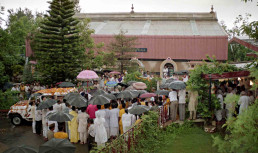
On August 8th, a long convoy brought Pujya Gurudev’s body back to His final resting place in Sidhbari. When His seated body was placed in Kamala Hall for the people of Himalayas and all others to offer their respects, He looked as bright and uplifting as He always did when alive. His favorite japa of “Om Namah Shivaya” surrounded Him as all devotees kept vigil until Pujya Gurudev’s last rites began. It was His wish to rest in the rose garden in front of His Kutiya facing the Dhauladhars that He loved. So, on the night of August 8th, the earth had been dug, 5 feet by 5 feet, 7 feet deep and lined with cement to receive the beloved son of Sidhbari.
In the early hours of August 9th, 1993, after a final darshan to all His beloved devotees, Pujya Gurudev’s body was placed facing the east as the last rites began. All Vedic rituals were performed with great solemnity to befit the Maha Purusha that Pujya Gurudev was. Pujya Gurudev’s body was bathed with Ganga water, milk, honey, ghee, camphor, sandalwood, incense, curds, and other aromatic substances in a last abhishekam performed amid reverential chanting of mantras for two hours. Then, His entire body was interred with salt according to Shastra vidhi, the scriptural injunctions. Starting with the Swamis and brahmacharins, everyone again paid their last respects with a common prayer that Pujya Gurudev’s Grace and blessings shall forever fill their hearts.
With the magnificent Dhauladhar standing guard in the backdrop, the austere Samadhi Sthal is breathtakingly meditative with its elegant combination of woodwork, clear glass, and rosy granite under a Kerala-style tiled roof crowned by a central golden Kalasha.
The structure is built in such a thoughtful manner that it opens up to seamlessly blend with the sylvan surroundings of Sidhbari. Constructed with devotion by Architect Mythili and her team in 1995, it was consecrated in a beautiful, solemn ceremony on Aug.3rd, 1995, by Pujya Guruji Swami Tejomayananda on the sacred occasion of the second anniversary of Pujya Gurudev’s Mahasamadhi day. It is an exquisite shrine among His beloved roses for an inimitable Guru who gloriously embodied the Auspicious Beautiful Truth – Satyam, Shivam, Sundaram – in every breath of His worshipful life.
Inside the Samadhi Sthal, Pujya Gurudev’s Presence is immediate, inspiring, and unmistakably powerful. The brilliant pratima of Pujya Gurudev Swami Chinmayananda is made out of panchadhatu – a combination of gold, silver, copper, zinc, and iron. It was made in Mahabalipuram near Chennai with great prayers. As we gaze at His Pratima, we are filled with a deep yearning to hear His Voice just one more time thundering the message of the Bhagavad Gita, the Upanishads. Almost immediately floods the realization that we can hear Him in our inspired hearts that are made pure with the teachings that He tirelessly illustrated in His every action. We understand that our dearest Pujya Gurudev was more than His physical form which is why He is ever available to every devotee who strives to walk behind Him.
We prostrate at the Lotus Feet of Pujya Gurudev’s Pratima. Overwhelmed with gratitude and reverence, we slip into an indescribable silence. His Grace enters us when our surrender is complete. That is the greatest blessing of Chinmaya Tapovan Sidhbari which we pray for in our lives.
Navigation
Next Topic
Samadhi Sthal
A hallowed space in Chinmaya Tapovan, the Samadhi Sthal of Pujya Gurudev Swami Chinmayananda (1916-1993) is an inspirational altar in the ashram. It is the…
Home Page
Nothing found.
Previous Topic
Samadhi Sthal
A hallowed space in Chinmaya Tapovan, the Samadhi Sthal of Pujya Gurudev Swami Chinmayananda (1916-1993) is an inspirational altar in the ashram. It is the…
Pahadi Upliftment
Pujya Gurudev used to describe true love as a dynamic giving, not a passive taking. One of his main objectives in starting the ashram at Sidhbari was to uplift the lives of the Pahadis, the natives of the Himalayan region who had served the saints and sages in the mountains of yore.

Pujya Gurudev used to describe true love as a dynamic giving, not a passive taking. Such was the exceptional love that He showered on the people of Himalayas, choosing Sidhbari as the place for the Chinmaya Tapovan ashram. So, the founding objectives of the Chinmaya Tapovan Trust was the spread of Vedanta as well as the service of those simple-hearted Pahadis.
Soon after Sandeepany HIM was inaugurated in April 1981, Pujya Gurudev initiated the efforts to serve the Pahadis in March 1982. There were no primary health care centers, and no hospital close enough for medical emergencies. So, Gurudev inaugurated a free medical dispensary, Tapovan Arogya Sadan, where Dr. Indumati Vaidya and Dr. Akhilam (Swamini Nishtananda) served. The manava seva project had struck roots with at least 30 villages benefiting at the very outset.
When Pujya Gurudev understood that women will be benefited most with proper maternal and child health care as multipurpose health workers (community nurses) got trained, He blessed and inaugurated the Chinmaya Rural Primary Health Care and Training Centre (CRPHC&TC) on April 10th, 1985.
“The people of the Himalayas, especially women, have selflessly served the wandering sadhus. This will be our repayment of ṛṣiṛiṅ (debt) to them. I want to serve them.” – Pujya Gurudev Swami Chinmayananda
The reach of the project grew by leaps and bounds as remote areas of Kangra Valley finally got medical help through six outreach health sub-centers. As more trainees became health workers, birth attendants, or village health guides, the need arose for a separate building which was completed in late 1986. The dispensary in the ashram was merged into the project.
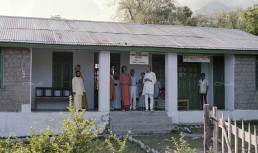
As the project grew, Dr. Kshama Metre came in November 1985, closing her pediatric practice in Delhi for good. After her magical, transformational meeting with Pujya Gurudev, she found both her Guru and her greatest calling at the same time in Sidhbari!
Chinmaya Tapovan Trust strengthened the project with the help of many ashramites. Sri Trilokinath, General Manager of CTT until 1994, assisted in the early years. The commitment of 75-year old Dr. Jayanti Mahimutra as the first director of CRPHC&TC was continued by Dr. Ramakrishna Sharma, retired Deputy Director of Health Services, Himachal Pradesh. Then, Sri K.R. Pai (Swami Ramananda) took over the project until Dr. Kshama Metre became the project director in 1987.
Pujya Gurudev’s guidance was like a mother’s care – gentle, patient, and nourishing. He emphasized on spirituality and character-building for seva to be effective.
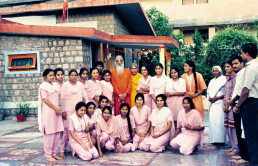
What started with maternal and child healthcare soon diversified to address the poverty, lack of education and livelihood resources, and poor awareness of hygiene, sanitation, and more. Thus evolved the acclaimed CORD – the Chinmaya Organisation for Rural Development. The empowered women became a driving force with their Mahila Mandals. CORD also motivated, mobilized, and enabled powerful community-based organizations, CBOs. The success that started in Sidhbari became a CORD saga which continues to empower not just the Pahadis but so many more across rural India.
In Sidhbari, Pujya Gurudev started a silent revolution with an expanding influence. While the rural women were learning the art of collective action and active participation, Pujya Gurudev turned His attention to the Pahadi children and youth. The Hari Hara vocational schools focused on children learning through field experiences and then getting trained in various vocations that would enrich them.
Sri Hansraj who came to Chinmaya Tapovan ashram as a youth speaks with affectionate reverence about the way his life was transformed by the Grace of Gurudev. In his words, we can hear gratitude for how Pujya Gurudev brought hope, confidence, and prosperity to the Pahadis.
Three Examples of Transformation
The following anecdotes illustrate, through an individual beneficiary’s story, how the CBOs and the four strategic principles enable CORD to transform the lives of the poor people who then mutually help each another. Moreover, the stories depict how CORD enriches various aspects of a person as a whole even though the entry point may be through any one of its program components. These excerpts are from the Mananam publication titled "Chinmaya Seva."
Nothing found.
Nothing found.
Pahadi Upliftment Videos
Navigation
Next Topic
Pahadi Upliftment
Pujya Gurudev used to describe true love as a dynamic giving, not a passive taking. One of his main objectives in starting the ashram at Sidhbari was to uplift…
Home Page
Nothing found.
Previous Topic
Pahadi Upliftment
Pujya Gurudev used to describe true love as a dynamic giving, not a passive taking. One of his main objectives in starting the ashram at Sidhbari was to uplift…
The Progress at Sidhbari
When we visit Sidhbari today, it is hard to imagine the unapproachable land that it was in the 1970s. Swami Chinmayananda’s vision made that metamorphosis in the mountains happen. The way the ashram has grown with the wholehearted teamwork of devotees reflects the purity and power of Pujya Gurudev’s sankalpa. Year after year, new buildings and facilities were added.

When we visit Chinmaya Tapovan Sidhbari today, it is hard to imagine the barren, unapproachable land that it was in the 1970s. Pujya Gurudev’s vision made that metamorphosis in the mountains happen. And the way the ashram has grown with the diligent, wholehearted teamwork of devotees of all backgrounds and talents reflects the purity and power of Pujya Gurudev’s sankalpa. Pujya Gurudev embedded in the growth many remarkable memories and lessons for all of us.
All the ventures undertaken, from the divine landmarks to the accommodating facilities and amenities, brick by brick on the outside and thought by thought on the inside, were centered around spiritual evolution for all who stepped into the Sidhbari ashram.




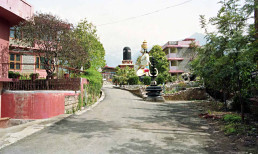
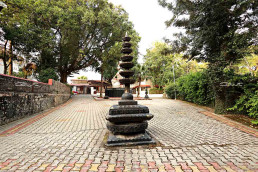
So much thought went into making the ashram self-sufficient. The nourishing touch of Pujya Gurudev was evident when the goshala, the cowshed, was set up in March 1989. Early days in Sidhbari meant tea with tinned milk powder. But that changed when the goshala with the cows and their tinkling bells became part of the ashram. Now fresh milk and the soothing moos of cows add to the sweet, serene joy inside Chinmaya Tapovan.
The newer buildings in Chinmaya Tapovan ashram are embellishing its ancient spiritual objectives.The new auditorium, Chinmaya Shatabdi Sabhaghar, built in the centenary year 2016 with a capacity to seat 670 people, resounds with the joy of many auspicious pujas and celebrations. Its open terrace where the Sidhbari skies glide over the meditative Dhauladhar mountain peaks unfolds the power of collective prayers during the blissful Vishnu Sahasranama Pujas.


The striking transformation in Sidhbari through the years is not just from new buildings and landmarks. The landscaping of the ashram and temple surroundings was done with aesthetic acumen by Pujya Gurudev. He gave clear instructions to Sri H.K. Madhwal, a retired forest officer, outlining the overall plan for the trees, the garden, the hedges and grass. In subsequent letters he writes: The idea of tree planting is sacred. Why not get a teak, a rose wood and a Chandan plant? Try these Brazilian Papaya seeds near the dining hall. Make seedling and then replant each.”
From the barren landscape to the green hermitage that it is now, the lush vegetation was nourished with great love and care by Sri. Madhwal after Vayuputra Veera Hanuman calmed the winds. It is wondrous to find an international mix of foliage – the California redwoods amid the deodars, camphor plants, African bamboo, and Australian eucalyptus. There is a vitalizing fragrance of a variety of exotic blooms of jasmine, lilies, champa, chrysanthemums, gardenias, and of course, the beautiful roses that Gurudev loved.
Chinmaya Tapovan is a spiritual nandavana where the splendor of Nature is undisturbed by the progress planned with care.
A list of buildings and the year of construction
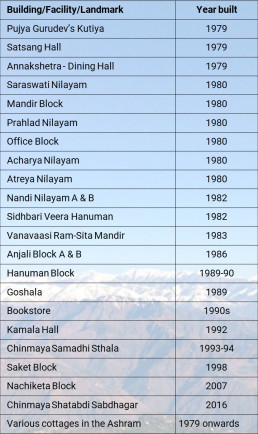

Aerial view of the land at Sidhbari
Navigation
Next Topic
The Progress at Sidhbari
When we visit Sidhbari today, it is hard to imagine the unapproachable land that it was in the 1970s. Swami Chinmayananda’s vision made that metamorphosis in…
Home Page
Nothing found.
Previous Topic
The Progress at Sidhbari
When we visit Sidhbari today, it is hard to imagine the unapproachable land that it was in the 1970s. Swami Chinmayananda’s vision made that metamorphosis in…
Spiritual Camps
Sidhbari is synonymous with Pujya Gurudev’s unforgettable spiritual camps. Pujya Gurudev would say: “It is absolutely necessary for spiritual Sadhaks to dry-dock to a quiet place like Sidhbari and listen to the spiritual Masters, deeply reflect on them, and lift the mind in contemplation on the Reality.”
The life force in Chinmaya Tapovan ashram is Vedanta. While Sandeepany HIM is the site for the two and a half years full-time Vedanta courses for enrolled students, Pujya Gurudev opened up the gates of the Sidhbari ashram to share the inspiring scriptures with people from all walks of life. So, Sidhbari is synonymous with the unforgettable camps that Pujya Gurudev first started which the Chinmaya Guru Paramapara continues.
In 1981, the inaugural year of the ashram, Pujya Gurudev invited the world to experience the bliss of the first camp at Sidhbari with Vivekachoodamani, the poetic Vedantic composition of Bhagavan Adi Shankaracharya. From Sep.4th – Oct.28th, 1981, Pujya Gurudev taught the exquisite text of 581 verses in five historic camps where he took the blessed audience to the enthralling heights of Vedanta.




It was the time when Sidhbari was hardly known, and the amenities in the ashram were the bare essentials. There were hardly any cottages or even beds. Yet, the sheer power of Gurudev’s discourses and the exalted subject matter swept everyone off their feet into a realm beyond physical wants.
Those first five camps were a magical penance with a routine that reined in the wandering senses and redefined time. Pujya Gurudev encouraged all to use the spiritual retreat as a time to embark on a single-pointed quest for the Highest. It was a time for temporary sannyas – to renounce the noisy wants of the world and step into the silence of the Self.
The 5 am meditation sessions with Gurudev were blissful. The eloquent brilliance of Gurudev’s examples in his daily discourses at 6:30 am and 7:30 pm had the audience spellbound. Gurudev directed delegates to walk in solitude through the pine forest for some time in the day to introspect in deep silence. The discussions and question-answer sessions with Brahmachari Vivek Chaitanya, the first Acharya of Sandeepany Himalayas, increased understanding. The evening satsangs in the ethereal dusk of Sidhbari uplifted all to the peaks of reflective stillness.
While the intellect was steered toward clarity, the heart was softened to experience the purity of devotion. The collective Vishnu Sahasranama Archana and the trip to the stream to offer the flower petals after the puja made hearts soar and sing with divine joy. The Paada pujas offered to Pujya Gurudev’s holy Feet were full of reverence.
The fragrance of knowledge and devotion also came through in the routine of those camps when all attendees could assist and volunteer in different ways during the days.
There were other special events that made these early camps stand out even more. The Dalai Lama visited Chinmaya Tapovan for a special satsang on October 3rd, 1981 during the third camp.
Oct.27th, 1981, during the fifth camp, Pujya Gurudev consecrated the very special idols of Sri Kirata Murti Shiva and Parvati along with Lord Ganesha in an intricately carved Mandap inside the Satsang Hall. He narrated the story of Arjuna being blessed with the Pashupataastra after Shiva, in a hunter’s guise, tested and wiped out Arjuna’s arrogance. Arjuna learned the importance of humility and complete surrender.
Even today, those reigning idols inside the Satsang Hall are Pujya Gurudev’s reminder to us about the importance of surrendering our vasanas during satsang.
When the final camp of the first Vivekachoodamani series concluded on Oct.28th, 1981, Gurudev conducted the landmark convocation ceremony, a tradition he had started since the first camp. Pujya Gurudev applied the chandana tilaka to bless each attendee and gave a certificate to recognize the completion of the verses in that session. Then, each attendee carried a lamp lit from the Akhanda Jyoti at Swami Tapovan Maharaj’s altar and placed it on their home-states on a map of Bharat. With that unique ritual, Pujya Gurudev emphasized the importance of each seeker spreading the light of knowledge in their hometowns.
Pujya Gurudev conducted about 43 camps in Sidhbari expounding on a vast range of introductory and Upanishadic texts. In several of the camps, Brahmachari Vivek Chaitanya melted hearts with his discourses on Tulsi Ramayana, sweetening the flowing Knowledge with nectarine devotion.
After those iconic camps of 1981, the flow of Knowledge, Jnana Ganga, from Sidhbari was incessant. Pujya Gurudev called the spiritual camps as a port for spiritual dry-docking. He said: “‘You all have come here for dry-docking, It is a must for spiritual Sadhaks. The ships, after a few voyages in the ocean, are dry-docked for a complete rehauling and repairs. It is absolutely necessary for spiritual Sadhaks to dry-dock to a quiet place like Siddhabari and listen to the spiritual Masters, deeply reflect on them and lift the mind in contemplation on the Reality. This constant listening, thinking and contemplating helps the corroded mind to drop all its dross that it gathered during its sojourn in the ocean of Samsaar. A mind thus repaired and properly tuned up, can expand and lift itself to a state of Pure Awareness and Bliss.”
Chinmaya Tapovan Sidhbari is truly a vibrant spiritual port. Throughout the years, many Swamis and Acharyas ferry their devotees from all over the world to ‘dock’ in the soothing serenity of Sidhbari. Spiritual camps in Hindi, English, and the regional Indian languages are conducted regularly, and the camp routine that Pujya Gurudev initiated is still implemented. Meditation, daily discourses, discussions, Q&A sessions, seva opportunities, bhajans, and the famous treks in the pine forests are key attractions. Pujya Gurudev’s Paduka Puja is a worshipful experience. And, the field trips to the Gaushala and CORD premises are cherished by all.
The camps also reach out to a varied audience. Chinmaya Tapovan Trust graciously hosts yearly CHYK camps, management camps, educational trips from Chinmaya Vidyalayas and colleges. The complete experience in Sidhbari is an uplifting, continuous blessing.
Spiritual Camp Videos
Camp attendees placed lamps on their home states after camps in the early years.
Paada Puja offered by the sisters of Pujya Gurudev
Pujya Gurudev used to distribute Prasada in a loving way after Paada puja.
Pujya Gurudev's powerful explanation of Sat-Chit-Ananda during a camp in Sidhbari
Pujya Gurudev enjoying a Malayalam bhajan before a bhiksha in Sidhbari
Pujya Gurudev enjoying a Pahadi bhajan
Navigation
Next Topic
Spiritual Camps
Sidhbari is synonymous with Pujya Gurudev’s unforgettable spiritual camps. He would say: "It is absolutely necessary for spiritual Sadhaks to dry-dock to a…
Home Page
Nothing found.
Previous Topic
Spiritual Camps
Sidhbari is synonymous with Pujya Gurudev’s unforgettable spiritual camps. He would say: "It is absolutely necessary for spiritual Sadhaks to dry-dock to a…
Ram Mandir
The presence of a devotee draws the Lord without fail. Pujya Gurudev carefully planned the location of the Ram Mandir such that the eyes of Sidhbari Veera Hanumanji could forever gaze at the Lotus Feet of Bhagavan Rama.

The first Hanuman Mastakabhishekam completed on Oct.10th, 1982, showered the funds to lay the foundation for a unique temple – the first temple for Sri Rama and His Consort Sita in the Himachal land where, though Tulsi Ramayana was revered, most temples were for Devi or Shakti.
On March 6th, 1983, during the Bhoomi puja, Pujya Gurudev remarked that the temple would be a Setu, bridging the cultures of North and South. And, the idols to adorn the temple were Vanavaasi Rama and Sita – their austerely beautiful forms during their exiled 14-year forest life. The idols were carved from soft black stone by a famous sculptor Sri B. Basavanna of Mysore.
While explaining the significance of the Vedic rituals after the Bhoomi Puja, as the divine idols of Sri Rama and Maata Sita were unveiled, Pujya Gurudev, with His typical humour, pointed out that “Lakshmana had gone to collect fruits!” Maybe Pujya Gurudev wanted us to remember that Lakshmana-like Vairagya must be in our hearts in a life of Tapas and Bhakti.
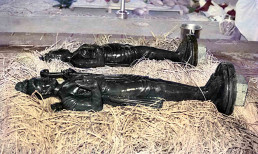
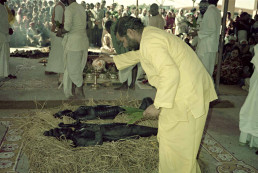
The Dhaanya Adhivaasa ritual on March 6th, 1983, was highly significant. The exquisite idols of Sri Rama Sita gracefully placed on a bed of grains to await installation were a heavenly sight. When people offered grains and even silver coins to the idols, Pujya Gurudev emphasized the importance of surrender, both spiritual and material.
A rare aspect of the Vanavaasi Ram Mandir is how the main altar of the temple is truly and literally founded on intense worldwide prayers. In response to Gurudev’s call for a Likhita Japa Yajna, 7844 devotees from 24 countries wrote “Om Sri Ram Jaya Ram Jaya Jaya Ram.” The total count of the written Japa was 28,84,875 when they were reverentially placed in the enclosure below the inner shrine.

Pujya Gurudev carefully planned the location of the Ramaalaya such that the eyes of Sidhbari Veera Hanumanji could forever rest at the Lotus Feet of His beloved Lord Rama. And, Pujya Gurudev emphasized how the ‘Kurma’ placed in the threshold of Sri Ram Mandir reminds devotees to withdraw all wandering senses for a fulfilling darshan of Bhagavan Rama.
The Mandir construction was completed in a record six months. Pujya Gurudev once remarked that “Hanumanji Himself was literally building the temple!” The entire Mandir is an aesthetic masterpiece of sacred beauty and symbolism.
In the video excerpts below, Sri Hemachandrudu of Lakshmi Constructions, Chennai, recalls the large-hearted love of Pujya Gurudev when credits were given for the temple construction.
The Kumbhabhishekam of the Vanavaasi Ram Mandir was a momentous three-day celebration with notable events. Oct.21st, 1983, began with Pujya Gurudev initiating a great blessing to Chinmaya Mission’s future. In a special diksha ceremony, Brni Yamuna Devi became Swamini Gangananda and Br. Radhakrishnan became Swami Jyotirmayananda. Br. Vivek Chaitanya, the first acharya of Sandeepany Himalayas was given sannyasa diksha to become the beloved Pujya Guruji Swami Tejomayananda, the global head of Chinmaya Mission from 1993 to 2016.
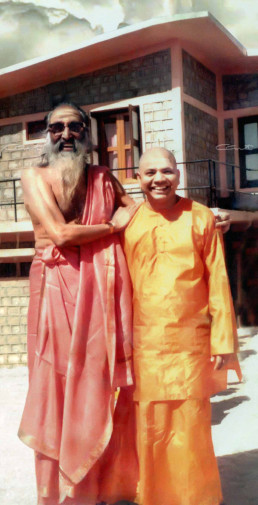

The whole atmosphere of Chinmaya Tapovan ashram was surcharged with spiritual vibrations on Oct.22nd when the newly initiated Swamis performed Kumbhabhishekam amid akhanda chanting of “Om Rama Ramaya Namah,” preliminary homa, pujas, archanas, and a Kalasha procession – all conducted flawlessly in Vedic style which filled the hearts of everyone.
Later on, when Pujya Gurudev performed Prana Pratishta to invoke Bhagavan’s Presence in the idols within the temple, the faces of Vanavaasi Rama Sita shone with a divine glow.
The consecration continued on Oct.23rd with the installation of Lord Ganesha and the Utsava Murtis – the idols of Ram Parivar.
Rare is the opportunity to witness a temple’s consecration. The devotees in Sidhbari, from the Governor of Himachal Pradesh to the simple Pahadi villager, were overjoyed by the grand celebrations of the Maha Kumbhabhisekham.
Today, as we prostrate inside that incomparable Vanavaasi Ram Sita Mandir in Sidhbari, we realize that here is an auspicious sanctum where Pujya Gurudev showed us the joy of penance, purity, deep faith, and devoted work.
From Veera Hanuman to Sri Ram - A panoramic view
Ram Mandir Videos
A glimpse of the Likhita Japa books which were later placed under the altar
Pujya Gurudev does Prana Pratishta for the newly installed idols.
Navigation
Next Topic
Ram Mandir
The presence of a devotee draws the Lord without fail. Once Veera Hanuman took up his abode in Sidhbari, His beloved Lord Rama also had to come there.
Home Page
Nothing found.
Previous Topic
Ram Mandir
The presence of a devotee draws the Lord without fail. Once Veera Hanuman took up his abode in Sidhbari, His beloved Lord Rama also had to come there.
